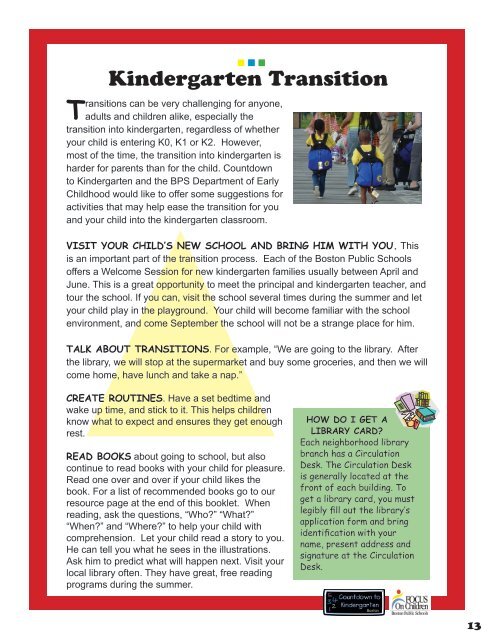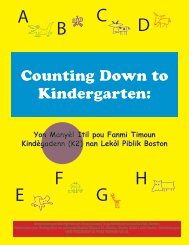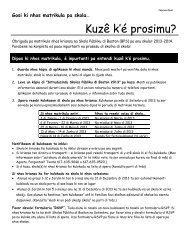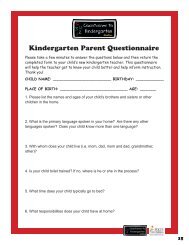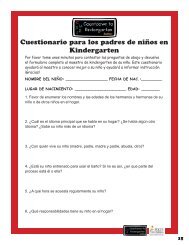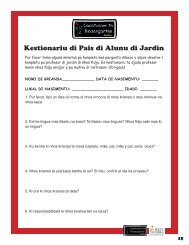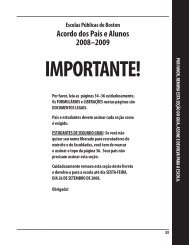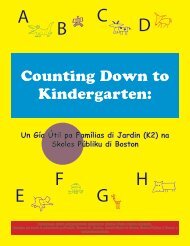Kindergarten Handbook - Countdown to Kindergarten
Kindergarten Handbook - Countdown to Kindergarten
Kindergarten Handbook - Countdown to Kindergarten
Create successful ePaper yourself
Turn your PDF publications into a flip-book with our unique Google optimized e-Paper software.
<strong>Kindergarten</strong> Transition<br />
Transitions can be very challenging for anyone,<br />
adults and children alike, especially the<br />
transition in<strong>to</strong> kindergarten, regardless of whether<br />
your child is entering K0, K1 or K2. However,<br />
most of the time, the transition in<strong>to</strong> kindergarten is<br />
harder for parents than for the child. <strong>Countdown</strong><br />
<strong>to</strong> <strong>Kindergarten</strong> and the BPS Department of Early<br />
Childhood would like <strong>to</strong> offer some suggestions for<br />
activities that may help ease the transition for you<br />
and your child in<strong>to</strong> the kindergarten classroom.<br />
VISIT YOUR CHILD’S NEW SCHOOL AND BRING HIM WITH YOU. This<br />
is an important part of the transition process. Each of the Bos<strong>to</strong>n Public Schools<br />
offers a Welcome Session for new kindergarten families usually between April and<br />
June. This is a great opportunity <strong>to</strong> meet the principal and kindergarten teacher, and<br />
<strong>to</strong>ur the school. If you can, visit the school several times during the summer and let<br />
your child play in the playground. Your child will become familiar with the school<br />
environment, and come September the school will not be a strange place for him.<br />
TALK ABOUT TRANSITIONS. For example, “We are going <strong>to</strong> the library. After<br />
the library, we will s<strong>to</strong>p at the supermarket and buy some groceries, and then we will<br />
come home, have lunch and take a nap.”<br />
CREATE ROUTINES. Have a set bedtime and<br />
wake up time, and stick <strong>to</strong> it. This helps children<br />
know what <strong>to</strong> expect and ensures they get enough<br />
rest.<br />
READ BOOKS about going <strong>to</strong> school, but also<br />
continue <strong>to</strong> read books with your child for pleasure.<br />
Read one over and over if your child likes the<br />
book. For a list of recommended books go <strong>to</strong> our<br />
resource page at the end of this booklet. When<br />
reading, ask the questions, “Who?” “What?”<br />
“When?” and “Where?” <strong>to</strong> help your child with<br />
comprehension. Let your child read a s<strong>to</strong>ry <strong>to</strong> you.<br />
He can tell you what he sees in the illustrations.<br />
Ask him <strong>to</strong> predict what will happen next. Visit your<br />
local library often. They have great, free reading<br />
programs during the summer.<br />
HOW DO I GET A<br />
LIBRARY CARD?<br />
Each neighborhood library<br />
branch has a Circulation<br />
Desk. The Circulation Desk<br />
is generally located at the<br />
front of each building. To<br />
get a library card, you must<br />
legibly fill out the library’s<br />
application form and bring<br />
identification with your<br />
name, present address and<br />
signature at the Circulation<br />
Desk.<br />
13


